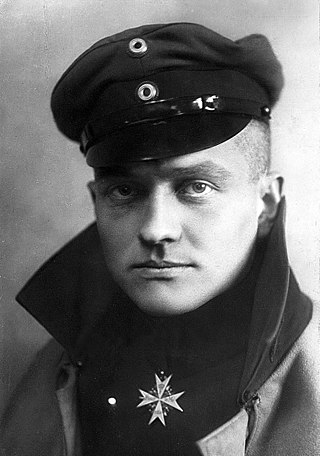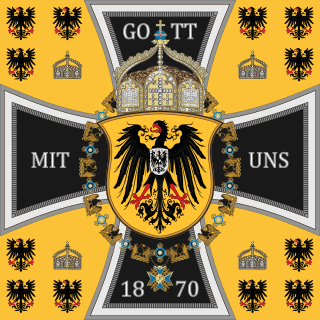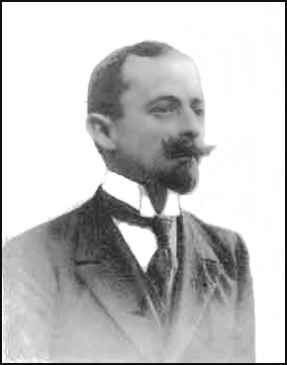Related Research Articles

Manfred Albrecht Freiherr von Richthofen, known in English as Baron von Richthofen or the Red Baron, was a fighter pilot with the German Air Force during World War I. He is considered the ace-of-aces of the war, being officially credited with 80 air combat victories.

The national flag of Poland consists of two horizontal stripes of equal width, the upper one white and the lower one red. The two colours are defined in the Polish constitution as the national colours. A variant of the flag with the national coat of arms in the middle of the white fess is legally reserved for official use abroad and at sea. A similar flag with the addition of a white eagle is used as the naval ensign of Poland.

Cecil William Mercer, known by his pen name Dornford Yates, was an English writer and novelist whose novels and short stories, some humorous, some thrillers, were best-sellers during the Interwar Period.

George Peter ("Pete") Murdock, also known as G. P. Murdock, was an American anthropologist who was professor at Yale University and University of Pittsburgh. He is remembered for his empirical approach to ethnological studies and his study of family and kinship structures across differing cultures. His 1967 Ethnographic Atlas dataset on more than 1,200 pre-industrial societies is influential and frequently used in social science research. He is also known for his work as an FBI informant on his fellow anthropologists during McCarthyism.

Claude (Claudius) Honoré Désiré Dornier was a German-French airplane designer and founder of Dornier GmbH. His notable designs include the 12-engine Dornier Do X flying boat, for decades the world's largest and most powerful airplane. He also made several other successful aircraft.

A roundel is a circular disc used as a symbol. The term is used in heraldry, but also commonly used to refer to a type of national insignia used on military aircraft, generally circular in shape and usually comprising concentric rings of different colours. Other symbols also often use round shapes.
Norman Leslie Robert Franks was an English militaria writer who specialised in aviation topics. He focused on the pilots and squadrons of World Wars I and II.

The Imperial German Army (1871–1919), officially referred to as the German Army, was the unified ground and air force of the German Empire. It was established in 1871 with the political unification of Germany under the leadership of Prussia, and was dissolved in 1919, after the defeat of the German Empire in World War I (1914–1918). In the Federal Republic of Germany, the term Deutsches Heer refers to the German Army, the land component of the Bundeswehr.

Herbert Smith was a British aircraft designer.

Military aircraft insignia are insignia applied to military aircraft to visually identify the nation or branch of military service to which the aircraft belong. Many insignia are in the form of a circular roundel or modified roundel; other shapes such as stars, crosses, squares, or triangles are also used. Insignia are often displayed on the sides of the fuselage, the upper and lower surfaces of the wings, as well as on the fin or rudder of an aircraft, although considerable variation can be found amongst different air arms and within specific air arms over time.

Key Publishing is a magazine publishing company specialising in aviation titles, based in Stamford, Lincolnshire, England.
The Naval Air Service was the air arm of the Hellenic Navy from 1915 to 1930.
Brigadier-General Gordon Strachey Shephard, was a Royal Flying Corps commander. He was the highest-ranking officer of the flying services to be killed in service during the First World War.

Ludovico de Filippi was an Italian naval officer and a pioneer of Italian aviation.

The Zeppelin D.I, or Zeppelin-Lindau D.I or Zeppelin D.I (Do), as named in German documents, also sometimes referred to postwar as the Dornier D.I or Dornier-Zeppelin D.I, for the designer, was a single-seat all-metal stressed skin monocoque cantilever-wing biplane fighter, developed by Claude Dornier while working for Luftschiffbau Zeppelin at their Lindau facility. It was too late to see operational service with the German Air Force (Luftstreitkräfte) during World War I.
Clayton Knight OBE was an American aviator during World War I. He was also an aviation artist and illustrator, and is known for being one of the founders of the Clayton Knight Committee and the illustrator of the comic strip Ace Drummond.

The Victory Medal (South Africa) is the Union of South Africa's version of the Victory Medal (United Kingdom), a First World War campaign medal of Britain and her colonies and dominions. The medal, never awarded singly, was awarded to all those South Africans who were awarded the 1914–15 Star or the British War Medal.

Raymond "Chaz" Bowyer was a Royal Air Force armaments and explosives instructor who, after he retired from service, wrote and edited over forty books relating to the operations, aircraft, and men of the Royal Flying Corps, Royal Air Force, and Royal Naval Air Service. He also edited for publication the memoirs of the pilots C.P.O. Bartlett, Eric Crundall, and Gwilym H. Lewis.

The Zeppelin-Lindau CL.II was a German single-engine two-seat biplane with an all metal structure, built by Zeppelin-Lindau during World War I.

Mihajlo Petrović was a Serbian military pilot who flew in the Balkan Wars of 1912–1913.
References
- ↑ "Back Issues". Cross and Cockade. Great War Aviation Society. Retrieved 1 April 2024.